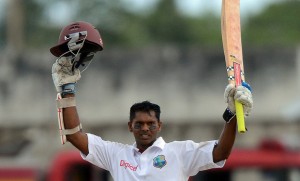– Shivnarine Chanderpaul is among the last of the cricketers around from the 1990s
By Scott Oliver

As one of cricket’s iconic players takes his final cricketing curtain call in Mumbai later this month, another of its great survivors, another enduringly boyish member of Test cricket’s exclusive 10,000-run club, will be watching from the opposing ranks, doubtless demonstrating the stickability that has been the hallmark of his crabbily productive batting down the years.
Shiv Chanderpaul’s career is a model of the adaptability and durability required to survive in the international arena. Indeed, his is already the third-longest Test career in West Indian history, behind only George Headley (who joins Sachin Tendulkar as one of only five men to have played Tests in four separate decades) and Garry Sobers, and by the time he steps out in Kolkata for the first Test, it will be the 20th longest of all.
Given the famous Buddhist aphorism about a journey of a thousand miles beginning with a single step, if you are to survive for two decades at the sharp end, you first need to work out how to survive for a session.
For Chanderpaul, that ability was developed in his formative years in rural Guyana.
“You learn to be tough in country cricket. We used to play ‘friendlies’ between ourselves, and you always want to bat first. You always say, ‘I’m first, I’m first’. The only way the others would get batting is if they get you out. You try everything to stay in. There are times when you’re out and you say you’re not out.”
The singled-mindedness is perhaps apt for someone who hails from Unity Village. Disputes over whether or not he was out never stopped the flow of bowling.
“The guys from the village would come out and just be throwing balls at me all day long,” Chanderpaul recalls with a gleeful smile.
Long hours
Four times he has batted undefeated for 1000 minutes, while he is the only man to have faced 1000 consecutive deliveries in Tests without being dismissed.
Notwithstanding a glorious 69-ball hundred against Australia in 2003, he is, to invert a line that could be used about any number of his teammates, generally there for a long time, not a good time.
“It’s the way I prepare myself: going in the nets and batting for hours and hours.
Thinking about the game – which goes for two-hour sessions, maybe two and a half– – I prepare that way in the nets.” Even so, to survive for a session, or for 1000 minutes, you need to be in a position to pursue a Test career in the first place, and Chanderpaul is in no doubt that, for the first major step up of his career, into the Guyana team, he owes a debt to the generosity of his club.
“Guys would turn up for their country, maybe play trial games, and wouldn’t get paid. So I had to find ways to pay all these things, and some people from my club helped me. I lived way up in the country and had to come to Georgetown to play cricket. My club president found some people to sponsor me, to pay for my transportation to come down to play. But not everyone got help. How were the players going to play if there’s no money there?” The span of Chanderpaul’s career –– he debuted in March 1994 –– almost exactly coincides with the decline of West Indies.
For all the theories about the pull of soccer in the region, and the allure of U.S. university scholarships for basketball or track and field, he is adamant about where the issues lay: “We played Red Stripe games in the past and would get maybe $150 or so for the whole game. How are you gonna survive on $150 per game? You play five games in the whole year. You can’t survive! When I came in, that’s what I was getting paid.”
Support
Thanks to the support of people in Unity Village, as well as no little talent and dedication, Chanderpaul was soon playing with the big boys. It wasn’t so easy at the grass roots.
“People from Guyana or Trinidad would leave for the USA or Canada to play cricket, because there was contracts there, and when they got back the local board members would say, ‘These guys are not interested in playing cricket’. I was thinking: Why are you saying that? The guys are breaking their contract and coming back home to play, and you saying they’re not interested in playing cricket! Right away that shows they’re committed. You’re not paying them a single cent to stay home and play, so they have to go overseas. They have to survive.”
Nevertheless, Chanderpaul is equally adamant that the good times are on their way back, with T20 sparking the revival – not just through the inspiration provided by West Indies’ World Twenty20 win in Sri Lanka last year, but the establishment of the Caribbean Premier League and its implications for the talented young players and cricketing ecology of his region.
“Cricket’s still the most popular sport in the Caribbean and now that we’ve started the CPL, which went well this year, it will be for a long time in the future. This is what people in the Caribbean have been waiting for. I guess more kids are going to be interested in the game and more parents are going to be interested in bringing their kids back into cricket. We have a few sponsors now, some money’s coming into the game, the players are going to be happy and cricket’s going to be booming again.”
Survival mode
As his own 17-year-old son, Tagenarine, starts out on his journey as a professional cricketer – father and son have played together for Guyana – Shiv, after a summer with Derbyshire, has to turn his attention to making runs for West Indies in the land of his forefathers.
It won’t be easy, which is often the way he likes it: “As a batsman, you don’t mind seeing the really flat pitches but it’s also good when there’s a challenge there for you and you have to dig in and you have to do well for your team. Sometimes you come out on top, sometimes you don’t.”
However harsh the sub-continental environment proves, Chanderpaul, hunkered under that crabby carapace (and his stance is likely to provide the majority of the sideways movement at both venues), will simply bang in his bail, same as always, and adapt: “Wherever you go there’s home advantage, you might say, and the conditions will suit the home team. As a player you have to find a way to deal with it. You have to survive.” (Cricinfo)

